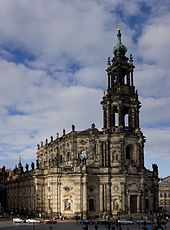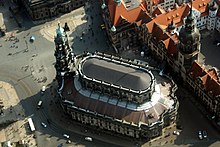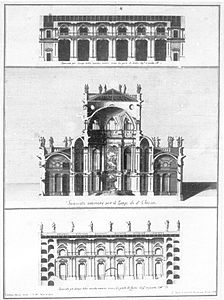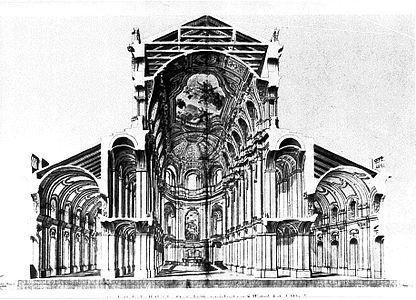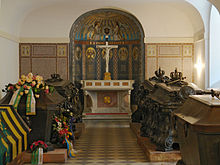Catholic court church
The Catholic Court Church in Dresden , consecrated to the Most Holy Trinity (Sanctissimae Trinitatis) , is the cathedral of the Diocese of Dresden-Meißen and a parish church of Dresden. It was built under Elector Friedrich August II of Saxony by Gaetano Chiaveri from 1739 to 1755 in the Baroque style. Already raised to a co- cathedral in 1964 , it became the cathedral of the diocese of Dresden-Meißen in 1980 when the bishopric was moved from Bautzen to Dresden.
As a former court church , it is connected to the residential palace by a passage over Chiaverigasse . It stands on the banks of the Elbe in the Old Town between Schlossplatz and Theaterplatz . Their planning began a decade after the start of construction on the Evangelical Frauenkirche , which is 300 meters away on Neumarkt.
history
August the Strong converted to Catholicism in 1697 in order to acquire the Polish royal crown. This caused concern in Evangelical Saxony, which increased when his son, Prince Elector Friedrich August , also converted in 1712 . His wedding to the imperial daughter Maria Josepha nourished the hope of Augustus the Strong one day to win the imperial crown of the Holy Roman Empire for his house. But he hastened to proclaim guarantees of freedom of belief for the population. Nevertheless he did not dare to arouse displeasure with a demonstrative church building; He celebrated Holy Mass discreetly in the palace chapel or, from 1708, in the opera house on Taschenberg, which was converted into a church . He generously sponsored the construction of the evangelical Frauenkirche , which the Dresden citizens built from 1726 as a monumental testimony of faith that towers over the entire city and which, in the spirit of the king, enriched the city skyline.
First his son, Friedrich August II., Who was elected Elector of Saxony in 1733 and, by election in 1734, Polish King August III. followed, now had the Catholic Court Church planned and built as a counter-sign, initially under strict secrecy, at first one spoke only of a "certain building". The Roman Gaetano Chiaveri , who also worked for the king in Warsaw, was commissioned with the planning in 1736, and the construction was carried out from 1739 to 1755.
As a result of the plan to build the Catholic Court Church between the Elbe Bridge and the castle , the moon bastion, the mint and the comedy house had to be demolished and the sea wall pushed forward. As early as the first half of the 16th century, most of the arches of the medieval Dresden Elbe bridge up to the 6th pillar were filled in to make room for the construction of the Georgentor and, two decades later, the Dresden fortifications . For the construction of the Catholic Court Church, the further backfilling and embankment up to the 8th bridge pillar took place in 1737. In the spring of 1740 the foundations, which Chiaveri had carried out with particular care, were completed. Similar to the Dreikönigskirche, the main axis deviated from the traditional west-east orientation as a result of the urban planning disposition, so that the choir is located in the south-west.
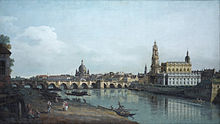
The Catholic Court Church is one of the main works of the Dresden Baroque , although it is the only large royal building that was designed by a foreigner and not by the architects of the Dresden Oberbauamt, who advised on the construction. The churches of Francesco Borromini and the Palace Chapel of Versailles are named as stylistic models for Chiaveri's building . The main yardstick was set by the neighboring kennel , the Theatrum Heroicum Augustus the Strong, to which his son now added a Theatrum Sacrum . Chiaveri's work stands up to the comparison with Pöppelmann's main work.
Chiaveri left Dresden in 1748 without construction being finished; There are some assumptions about the causes, but they do not exclude annoyance about the hesitant construction process or differences with local architects. After his departure there were still changes to his design, in particular to the organ loft and the boxes of the royal family, which the Oberland architect Johann Christoph Knoeffel designed in rococo forms, which the Italian baroque architect would hardly have accepted; The painting with a ceiling painting, as envisaged by Chiaveri, was dispensed with. In addition to Knöffel, his successor Julius Heinrich Schwarze and his future successor Friedrich August Krubsacius contributed their ideas to the tower . In addition to the dome of the Frauenkirche, it now shaped the silhouette of the city. “In Europe at that time, where denominational disputes still flared up, there was no other capital in which two of the most representative churches of the two major denominations jointly determined the cityscape in a small old town” ( Joachim Menzhausen ).
The Apostolic Nuncio in Poland, Archbishop Albert von Archinto , consecrated the Court Church of the Most Holy Trinity (Sanctissimae Trinitatis) on June 29, 1751 . For the consecration service, the Mass in D minor and the Te Deum in D major by Johann Adolph Hasse were performed. After the completion of the court church, the court chapel in the opera house on Taschenberg was rebuilt into a ballroom in 1755. In 1765 Chiaveri stayed in Dresden again for a short time.
The tower of the Catholic Court Church was extensively repaired from 1867 to 1868 under the direction of the Dresden city architect Adolph Canzler , as the Pirna sandstone had become so damaged by the weather that smaller and larger boulders fell on the lively castle square . From 1901 to 1903 the tower was completely repaired because the outer shell was weathered again. In some cases, the previous restoration attempts, in which cement mortar and staples, dowels and anchors made of iron were used, caused new damage. The new restoration was carried out with crossings made of Posta sandstone and with brackets and anchors made of solid copper.
In 1900 the church was connected to the first German district heating and electricity plant via an underground district heating channel , which in addition to the Hofkirche supplied other buildings on Theaterplatz and Brühlscher Terrasse with heat and electricity.
During the air raids on Dresden from February 13 to 15, 1945, the church was hit several times by high-explosive bombs . The roof and vaults in the interior collapsed. The outer walls were damaged, in some cases they were completely destroyed. The reconstruction lasted until 1965. The traces of the destruction can still be recognized today by the different stone colors of the nave. Three of the magnificently designed corner chapels have been restored almost true to the original. The fourth received a new design. The product that is also never executed ceiling paintings by Tiepolo planned ceiling mirror was added only in the course of the renovation of the 1990th
- Design drawings
Cross-section through the nave and elevations of the central nave wall, design by Lorenzo Zucchi after Gaetano Chiaveri , Kupferstichkabinett Dresden
Cross-section, Sebastian Wetzel 1747, signed by Gaetano Chiaveri. The planned interior decoration of the Hofkirche failed because of the classicism that would later prevail in Dresden.
Architecture and equipment
Outer shape

The church is a late example of European baroque. From the outside (especially from the side), the high, free-standing central nave and the lower aisle surrounding it are clearly visible. This arrangement results in a special feature of the church: a main tower that sits in the middle, but not directly on the central nave, but "only" adjoins the aisle. At the top of the tower is an inscription in large gold letters on stone. This begins with “DOM”, which stands for Deo Optimo Maximo (German: “To the best and highest God”, a title that was reserved for the Supreme God Jupiter in the Roman Empire).
Church dimensions:
- Gross floor area : 4800 m² (measured against this, the Hofkirche is the largest church building in Saxony)
- Total length: 92 m
- Total width: 54 m
- Tower height: 86 m
- Central nave (internal dimensions): 52.36 m (length) × 17.56 m (width) × 32.20 m (height)
- Side aisles (internal dimensions): 39.20 m (length) × 9.52 m (width) × 15.95 m (height)
Figure decorations
On the facade and on the balustrades there are 78 statues of saints, which were designed by the Italian sculptor Lorenzo Mattielli and the Dresden sculptors Paul and Jakob Mayer . The court confessor Ignaz Guarini also had an influence on the design .
In detail, in the niches next to the main entrance, there are the four evangelists: John and Matthew on the left and Mark and Luke on the right. The apostles Peter and Paul stand in the niches above the entrance, surrounded by the four Christian virtues Fides (faith), Spes (hope), Caritas (charity) and Iustitia (justice). At the top of the tower are the saints: Francis de Sales, Ida, Mauritius, Hubertus, Chrysostomus, Augustus, Norbert and Stanislaus of Krakow.
On the nave, on the lower balustrade, clockwise: Andreas, Thomas, Jacobus minor, Simon, Sebastian, Katharina, Joseph, Lucia, Franz von Paola, Johann Nepomuk, Laurentius, Venantius, Bernhard von Clairvaux, Agnes, Maria Magdalena, Florian, Wenceslaus, Vinzenz von Paul, Anton von Padua, Rosalia, Rochus, Franz von Assisi, Basilius, Stephanus, Casimir, Barbara, Irene, Raymund, Johannes Franz Regis, Franz von Borgia, Franz Xaver, Ignaz von Loyola, Thomas von Aquin, Anna , Apollonia, John the Baptist, Judas Thaddäus, Philip, Jacobus maior and Bartholomäus.
The upper balustrade is made up of: Magnus, Emperor Heinrich, Aloysius, Dominicus, Theresia von Avila, Stanislaus Kostka, Petrus von Alcantara, Felix von Cantalice, Georg, Leopold, Karl Borromäus, Caecilia, Benno, Magdalena de Pazzi, Clara, Benedict von Nursia, Ludwig the Holy and Procopius.
In the two niches at the rear of the church are the doctors Augustine and Ambrosius.
Interior design
The interior is divided into a main nave, two side aisles and four corner chapels. A special feature is the two-story processional walkway that runs around the main nave. Since any outdoor Catholic religious practice was prohibited in Protestant Saxony and the city succeeded in prohibiting processions by the court community outside the building, it was integrated into the church. The four corner chapels are the Kreuzkapelle in the west, the sacrament chapel, painted by Stefano Torelli , in the south, the Benno chapel in the east, in which the miter of St. Benno von Meißen has been kept and venerated as a relic on the altar there since 1998 , and the Johann Nepomuk Chapel in the north. The latter is also called the Gedächtniskapelle, as a memorial for the victims of February 13, 1945 was set up in it in 1973. For this, Friedrich Press created a modern Pietà made of Meissen porcelain .
Equipment
Particularly noteworthy is the carved Baroque pulpit by Balthasar Permoser , which was created for the Old Court Church in the opera house as early as 1712 and for which Johann Joseph Hackl , who also carved the confessional boxes, created the sound cover after it was moved to the Court Church in 1748 . The carvings were painted white alabaster varnish. The 4.20 meter high crucifix and the six silver candlesticks are the work of Joseph Ignaz Bauer from Augsburg. The pictures of the side altars “Joseph's Dream” and “Victory of the Christian Religion” are by Anton Raphael Mengs . Permoser created two figures of the scourged Christ in the tomb. His two sculptures of the church fathers Augustinus and Ambrosius, which were created for the Opera Church and were brought to the Petrikirche in Bautzen in 1751 , are also in the cathedral today. A marble statue of John the Baptist by the Roman sculptor Francesco Mochi from 1601/1650 is located above the baptismal font created by Permoser in 1721 in the east side aisle of the cathedral.
High altar
The Aglio brothers created the high altar from marble and gilded bronze ornaments. Above this is the altar painting, created by the Dresden court painter Anton Raphael Mengs from 1752 to 1761, which depicts the Ascension of Jesus Christ and is 10 meters high and 4.50 meters wide. The painting, begun in Rome in 1752, came to Dresden in 1765. The court gallery sculptor Joseph Deibel designed the frame.
In the vertical the picture is structured by a strong contrast between rather cool, dark colors in the observing disciples and yellow, gold and white shades in the upper part symbolizing the Trinity. God the Father, Spirit (dove as the brightest point in the painting) and Son form an axis. While Mary and the disciples look up in adoration or excitement, John's gesture is full of tension (here the apostle and evangelist - book in the left arm - are traditionally identified). The look up and the kneeling on the ground cross with the outstretched hand pointing downwards, as if Mengs wanted to remind us not to forget the relation to earth, to the man Jesus , despite all the glorification of Christ . A triangle standing on its point in the upper half of the picture corresponds to a triangle formed by the disciples and Jesus, the base of which is marked by John's arm.
Martyr altar
In the left aisle is the martyr's altar with the urns of the three martyrs Alois Andritzki , Bernhard Wensch and Aloys Scholze , whose ashes were brought here in a procession from the Old Catholic Cemetery on February 5, 2011 . Then on June 13th of the same year Alois Andritzki was beatified in a pontifical office in front of the cathedral.
Organs
Silbermann organ
In the court church there is an organ designed by Gottfried Silbermann , which was built by his students. It is the latest and at the same time the only surviving of the four former works of the master in Dresden. Two weeks after the conclusion of the construction contract on July 22, 1750 for the very high price of 20,000 thalers - at the encouragement of Silbermann by the king - Silbermann, who was seriously ill with gout, entrusted the construction management to his student and employee Zacharias Hildebrandt . After Silbermann's death in 1753 , he and his son Johann Gottfried Hildebrandt largely completed the work in 1754. The intonation was probably done by Silbermann's employees Adam Gottfried Oehme and Johann Georg Schön , who continued the Freiberg workshop. Johann Joseph Hackl created the organ's façade, which is richly decorated in terms of figures and ornaments . The instrument was consecrated on February 2, 1755.
The organ has 47 registers on 3 manuals and pedal and has about 3000 pipes . Originally 66 registers were planned. The disposition remained unchanged over the next two centuries. Only the mood and the wind supply changed. The pipework, the action and the console were moved to the cloister of the St. Marienstern monastery in 1944 and thus escaped destruction in the Second World War. The housing and the wood-carved prospectus were destroyed in the war , as were parts of the wind supply (bellows) and the Unda maris register .
From 1963 onwards, the organ work, which was only slightly changed in the 19th and 20th centuries, was restored to approximate the original and partially technically redesigned. On May 30, 1971, the organ sounded again for the first time in a service. The case and prospectus were reconstructed from 1980 with all forms of jewelry on the basis of photographs and other documents by Walter Thürmer and after his death by Thomas Jäger on the basis of old photos. In order to bring it closer to its original condition, the organ building workshops Wegscheider and Jehmlich restored the organ again in 2001/2002. It received a new bellows system based on the historical model and the original pitch of 415 Hz. The pipework was revised to conserve and reconstruct. On November 3rd, 2002 the instrument was inaugurated again and now has the following disposition:
|
|
|
|
|||||||||||||||||||||||||||||||||||||||||||||||||||||||||||||||||||||||||||||||||||||||||||||||||||||||||||||||||||||||||||||||||||||||||||||||||||||||||
- Pair : I / II, III / II, II / P
- Playing aids : tremulant, shut-off valves, beat for OW, Kalkantenzug
Remarks:
Recordings from the Silbermann organ
- Ludwig Güttler 17: Music for trumpet, corno da caccia and organ. Eterna - LP 7 25 092 (recording from 1985).
- Herbert Tachezi : Johann Sebastian Bach (BWV 565, 552, 542, 582). Eterna - LP 7 29 012 (recording from 1984, also published as MC), 1986, Teldec-LP 6.43119 (1985), Teldec-CD 8.43119 (1985).
- Herbert Tachezi: Johann Sebastian Bach (BWV 564, 526, 768, 668). Eterna - LP 7 25 013 (recording from 1984, also released as MC), 1986.
- Herbert Tachezi: Toccata & Fugue (BWV 565, 552, 542, 582, 564). Teldec - CDs 0630 18652-2, 1991 and 857389287-2, 2001 (contain the Eterna recordings with Tachezi).
- Hansjürgen Scholze: The Silbermann organ in the Dresden Cathedral. Motet CD, 1992.
- Johannes Ernst Köhler : Johann Sebastian Bach - The organ work on Silbermann organs. Vol. 10. 1999.
- Johannes-Ernst Köhler: Johann Sebastian Bach - Organ Works / Five Organ Concerts by Various Masters BWV 592 - 596. (Recording from July 1972, Eterna LP No. 8 26 352., CD 0090 472 BC from Berlin Classics )
- Hansjürgen Scholze: The Silbermann organ of the Hofkirche in Dresden. 2000.
- Franz Raml : Johann Sebastian Bach: Organ Works. 2005.
- Jolanda Zwoferink: Bach Organ Works I – III - Gottfried Silbermann-Organ Cathedral Ss. Trinity (Court Church) Dresden. 2011, 2013, 2015.
- Hansjürgen Scholze: The Silbermann organ cathedral Dresden. 2013.
- Hansjörg Albrecht : Vivaldi in Dresden. CD OehmsClassic music production, 2015.
- Johannes Trümpler : Bach !? - Cathedral organist Johannes Trümpler plays Bach and Bach arrangements on the Sibermann organ. Motette-Verlag, 2017.
Choir organ
The choir organ was completed by Jehmlich in 2000. The instrument has ten registers on a manual and pedal.
|
|
||||||||||||||||||||||||||||||||||||
Bells
The court church initially had to do without bells, since the following was stipulated in 18th century Saxony: “The Lutheran religion is the ruling here and in the whole country; but other Reformed and Catholic Christians have their free worship and their own chapels, only without bells ”. August III. had commissioned a bell from the Dresden bell founder Johann Gottfried Weinhold in 1747 ; However, this first had to be stored in the main armory. With the Peace of Poznan in 1806, the practice of Roman Catholic worship was made possible through equality of freedom of belief in Saxony. In this context, the bells could also be completed and hung. In 1807 , Friedrich August the Just donated three bells to the existing large bell from 1747 . The smallest bell fell in the bombing raid on February 13, 1945 . After the war, the bells were hung in a makeshift bell cage from the iron rubble of the city. On the occasion of the 250th year of consecration of the cathedral, the bell was extended to include the Holy Spirit bell - with the inscription: Anno domini 2001, in the 250th year of consecration of the court church . All bells were hung in a timbered oak bell cage.
The bells are rung as follows: The avebell rings in the morning, at noon at 12 o'clock and in the evening to the angel of the Lord . The bell of the Holy Spirit acts as the bell for the weekday masses . The holy spirit, holy cross and holy trinity bells sound at the parish masses on Sunday . The four small bells ring in the Sunday high, chapter or pontifical mass. All five bells are only rung on the highest feast days.
|
No. |
Surname |
Casting year |
Foundry, casting location |
Diameter (mm, approx.) |
Mass (kg) |
Percussive ( HT - 1 / 16 ) |
Placement of the bell chamber |
| 1 | Divine Providence | 1747 | Johann Gottfried Weinhold | 2,040 | 4,860 | g 0 +2 | back |
| 2 | Most Holy Trinity | 1807 | Heinrich August Weinhold | 1,720 | 2,850 | b 0 −5 | bottom right |
| 3 | Holy Cross | 1807 | Heinrich August Weinhold | 1,360 | 1,122 | d 1 +2 | bottom left |
| 4th | Holy Spirit | 2001 | Art and bell foundry Lauchhammer | 1,230 | 1,215 | f 1 +2 | top right |
| 5 | Ave Maria (angelus bell) | 1978 | Franz Peter Schilling, Apolda | 1,100 | 581 | g 1 −6 | top left |
Wettiner crypt and bishop's crypt
The Catholic Court Church was built with grave vaults and the donor's crypt was laid out at the beginning. Four days after the consecration of the church in 1751, the coffins of three deceased children of the electoral couple were transferred to the crypt of the Catholic Court Church. In the Great Crypt under the right aisle, the so-called Anton's Crypt, burials took place from 1763. In 1823, the master builder Christian Friedrich Schuricht expanded the church's crypt to include the royal crypt, creating a total of three crypt rooms. The fourth, the New Crypt, was laid out under the left aisle around 1900. These four crypt rooms of the Wettin crypt are connected to each other by corridors.
A total of 49 members of the Albertine line of the House of Wettin as well as their spouses and children found their final resting place in the Wettiner crypt of the court church. The kings who were buried in the Wettiner crypt are August III. (King of Poland), Friedrich August I , Anton von Sachsen , Friedrich August II. , Johann von Sachsen , Albert von Sachsen , Georg von Sachsen and Friedrich August III. (all kings of Saxony). The heart of Augustus the Strong is located in a capsule in the so-called donor crypt.
The fifth crypt of the Neue Gruft is the youngest crypt, the Bishop's Crypt, accessible, but it is not part of the Wettin crypt: Since the Catholic Court Church was elevated to a cathedral in 1980, it has also served as a burial place for the bishops of the Diocese of Dresden since then -Miss . In 1988, the bishop's crypt was therefore laid out, in which Gerhard Schaffran found his final resting place in a wall grave in 1996 .
Church life
Norbert Büchner, who had previously worked as a pastor in Pirna from 2001, has been the cathedral pastor of the cathedral parish since 2014. In addition, the cathedral chapter of St. Petri Dresden under the dean of the cathedral Andreas Kutschke has its seat at the cathedral. As such, it also serves the diocesan bishop , Heinrich Timmerevers since 2016 , as a place of preaching and various pontificals . In addition to two masses every weekday and one evening mass on Saturday evening, five Sunday masses , one of which is in Polish, form the core of the spiritual life in the church.
The Dresdner Kapellknaben , founded in 1719 as a boys' choir for the Catholic Hofgottesdienst, make under Domkapellmeister Matthias Liebich usually (except during holiday periods) worship on Sundays and public holidays, special services like the Pontifikalämter to solemnities or the Te Deum to the financial statements, and Vespers for the parish fair or the passion. In addition to this traditional ensemble, two other choirs, the cathedral and the community choir, help to organize the services.
Johannes Trümpler was appointed as the cathedral organist on April 1, 2015 . The Silbermann organ can be heard next to the organs of the Frauenkirche, the Kreuzkirche and the Kulturpalast, the venue of the “Dresden Organ Cycle” and so can also be heard regularly in concert.
The parish fair is on November 5th.
History of Church Music
Due to its function as the church of the music-loving Wettins, the court church played an important role in the care of church music for centuries. Until the end of the monarchy, it was one of the duties of today's Sächsische Staatskapelle Dresden as an electoral or royal court orchestra to accompany up to three hundred services a year. Until the introduction of separate posts for opera and church services, the court conductor was equally responsible for all services of the court orchestra. In this function, Johann Adolph Hasse , Johann Gottlieb Naumann and Carl Maria von Weber also conducted music performances here and added their own church music compositions to the repertoire of the court orchestra, most of which were premiered in the court church. This tradition ended with Richard Wagner , who was rather indifferent to church service, and from then on the court conductor limited himself to conducting the secular tasks of the orchestra. Its traditional connection with the current cathedral continues through the voluntary participation of members in orchestral masses at high festivals.
Former organists
- Christlieb Siegmund Binder , court church organist from 1764, d. 1789
- Anton Teyber , first court organist 1787–1791
- Anton Dreyssig , 1800–1813 or later
- August Alexander Klengel , 1816–
- Edmund Kretschmer , 1854–1901
- Gustav Adolf Merkel , 1864–1885
- Paul Walde , 1922–
- Hansjürgen Scholze, 1972-2008
- Thomas Lennartz , 2008-2014
Trivia
The tower of the Catholic Court Church is the viewer's imaginary vantage point for the panorama image of Dresden in the Baroque era in the Dresden Panometer .
In the novel, Green Dresdner by Marcus Wächtler is the high altar in the nave of one of the possible hiding places of the missing diamonds.
literature
- Johannes Derksen : A house full of glory. St. Benno Verlag, Leipzig 1962.
- Friedrich August Forwerk: History and description of the Catholic court and parish church in Dresden. Dresden 1851. ( digitized version )
- Jürgen Helfricht : Dresden and its churches. Evangelische Verlagsanstalt, Leipzig 2005, ISBN 3-374-02261-8 .
- Eberhard Hempel : Gaetano Chiaveri, the architect of the cath. Court church in Dresden. Dresden 1955.
- Thorsten Pietschmann: Dresden. Architecture and Art (= Cybela Picture Guide Architecture and Art , Volume 2). Cybela Verlag, Oybin-Lückendorf 2013, ISBN 978-3-944470-00-9 .
- Christoph Pötzsch : Episodes around the Hofkirche in Dresden. Tauchaer Verlag, 2002, ISBN 3-89772-052-3 .
- Siegfried Seifert, Klemens Ullmann : Catholic Court Church Dresden: Cathedral of the Diocese of Dresden-Meißen - 1751–2001 - 250 years. St. Benno Verlag, Leipzig 2000, ISBN 3-7462-1392-4 .
- Clemens Ullmann , Udo Pellmann: Catholic Court Church Dresden Cathedral Ss. Trinity. Pellmann, Dresden 1994.
- Rainer Thümmel : Bells in Saxony: sound between heaven and earth . Evangelische Verlagsanstalt, Leipzig 2011, ISBN 978-3-374-02871-9 , pp. 156 ff .
- Heinrich Stöckhardt : The Catholic court church in Dresden. Dresden 1883. ( digitized version )
Web links
- The Catholic Court Church on the website of the Diocese of Dresden-Meißen
- Hofkirche am Theaterplatz - Interactive 360 ° panorama (requires Java )
Individual evidence
- ↑ Norbert Oelsner : The Dresden Elbe Bridge in the Middle Ages and in the early modern period . In: Dresdner Geschichtsverein (Ed.): Dresdner Elbbrücken in eight centuries (= Dresdner Hefte . Volume 94 ). 2008, ISBN 978-3-910055-90-2 , ISSN 0863-2138 , pp. 6 .
- ↑ Eberhard Hempel , Fritz Löffler : The Catholic Court Church in Dresden. In: The Christian Monument , Issue 32, 1979, p. 12.
- ^ Hagen Bächler, Monika Schlechte: Guide to the Baroque in Dresden. Dortmund 1991, p. 94.
- ↑ Joachim Menzhausen: cultural landscape of Saxony. A millennium of history and art. Amsterdam / Dresden 1999, p. 164.
- ^ Adolph Canzler : The restoration of the tower of the Catholic court church in Dresden. In: Deutsche Bauzeitung , vol. 6 (1872), pp. 229–230 ( digitized part 1 ), p. 236–238 ( digitized part 2 ).
- ^ Köhler (government builder): The repair work on the tower of the Catholic court church in Dresden. In: Zentralblatt der Bauverwaltung , Vol. XXIV, No. 47 (June 11, 1904), pp. 297–301, urn : nbn: de: kobv: 109-opus-37597 .
- ^ Dankwart Guratzsch: Dresden Court Church with new vaulted ceiling. Retrieved March 20, 2018 .
- ↑ Ernst Flade: The organ builder Gottfried Silbermann . 1926 ( archive.org [accessed February 24, 2020]).
- ↑ Frank-Harald Greß : The organ of the Catholic court church in Dresden . In: Franz Josef Stoiber (ed.): Beautiful organs. Building history - sound - prospect design (= 283rd publication by the Society of Organ Friends ). Figaro, Laaber 2019, ISBN 978-3-946798-17-0 , pp. 74-81 .
- ^ Frank-Harald Greß: Die Orgeln Gottfried Silbermanns (= publications of the Society of Organ Friends. Volume 177). 3. Edition. Sandstein, Dresden 2007, ISBN 978-3-930382-50-7 , p. 123; Marc Schaefer (Ed.): The Silbermann Archive. The handwritten estate of the organ maker Johann Andreas Silbermann (1712–1783) (= Prattica Musicale. Volume 4; publication by the Society of Organ Friends. No. 123). Amadeus, Winterthur 1994, ISBN 3-905049-39-2 , p. 464.
- ↑ Dresden Cathedral (formerly Catholic Hofkirche) , on jehmlich-orgelbau.de, accessed on May 22, 2017.
- ↑ Johann Sebastian Bach - Organ Works 21 (Five Organ Concerts According to Different Masters BWV 592-596) - ETERNA - 8 26 352 - Johannes-Ernst Koehler Johann Sebastian Bach: Amazon.co.uk: Music. Retrieved February 25, 2020 .
- ↑ Catholic Court Church, Dresden. Retrieved February 25, 2020 (Italian).
- ^ Rainer Thümmel: Bells in Saxony: sound between heaven and earth . Evangelische Verlagsanstalt, Leipzig 2011, ISBN 978-3-374-02871-9 , pp. 156 .
- ^ Johann Christian Hasche : Diplomatic history of Dresden - from its creation to our days. Part 2, 1817, p. 649 ..
- ↑ Dresden, Cathedral (formerly Hofkirche): b ° -d'-f ' on youtube.com, accessed on May 22, 2017.
- ^ Felix Löwe, Diocese of Dresden-Meißen: Dresden (DD) bells of the cathedral Ss. Trinitatis (former court church). June 20, 2019, accessed June 25, 2019 .
Coordinates: 51 ° 3 ′ 12.6 " N , 13 ° 44 ′ 14.6" E
